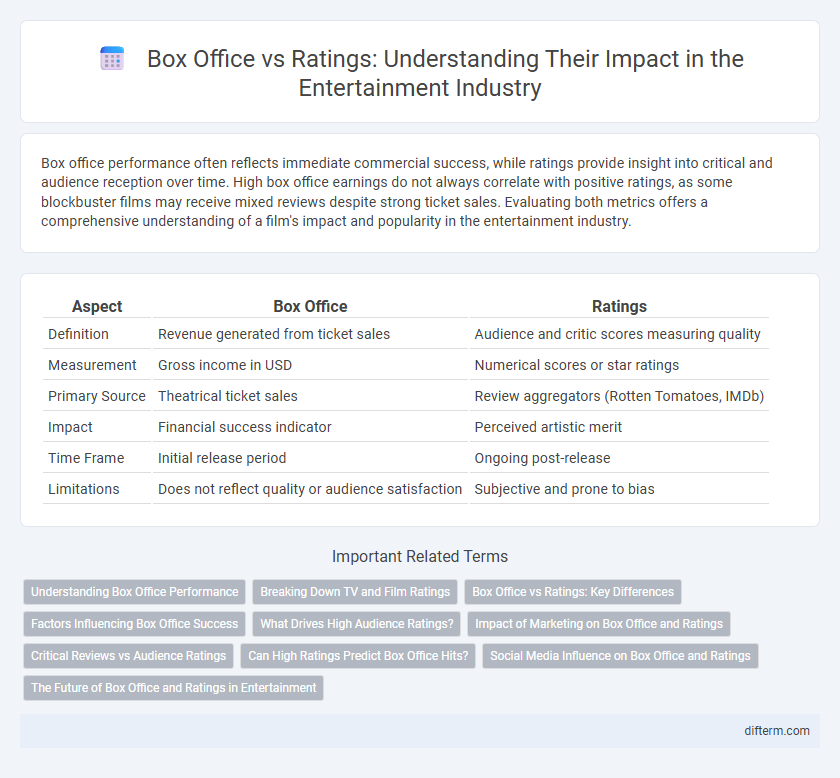Box office performance often reflects immediate commercial success, while ratings provide insight into critical and audience reception over time. High box office earnings do not always correlate with positive ratings, as some blockbuster films may receive mixed reviews despite strong ticket sales. Evaluating both metrics offers a comprehensive understanding of a film's impact and popularity in the entertainment industry.
Table of Comparison
| Aspect | Box Office | Ratings |
|---|---|---|
| Definition | Revenue generated from ticket sales | Audience and critic scores measuring quality |
| Measurement | Gross income in USD | Numerical scores or star ratings |
| Primary Source | Theatrical ticket sales | Review aggregators (Rotten Tomatoes, IMDb) |
| Impact | Financial success indicator | Perceived artistic merit |
| Time Frame | Initial release period | Ongoing post-release |
| Limitations | Does not reflect quality or audience satisfaction | Subjective and prone to bias |
Understanding Box Office Performance
Box office performance reflects the financial success of a film, often influenced by factors such as marketing, release timing, and star power. Ratings and reviews offer critical and audience perspectives but do not always correlate with ticket sales. Analyzing box office data alongside viewer ratings provides a comprehensive understanding of a movie's overall impact and market reception.
Breaking Down TV and Film Ratings
Box office revenue serves as a direct metric of a film's commercial success, while TV and film ratings provide insight into audience engagement and critical reception. Breaking down ratings involves analyzing quantitative scores from platforms like Nielsen, Rotten Tomatoes, and IMDb, which reflect viewer preferences and critics' evaluations. Understanding the correlation between box office performance and ratings helps studios gauge both market impact and cultural resonance.
Box Office vs Ratings: Key Differences
Box office performance measures a film's financial success through ticket sales, reflecting audience turnout and market demand. Ratings assess critical and viewer evaluations, providing insight into a movie's quality and entertainment value. While box office indicates commercial popularity, ratings reveal audience satisfaction and critical acclaim, highlighting the dual metrics of cinematic achievement.
Factors Influencing Box Office Success
Box office success is primarily influenced by factors such as star power, marketing campaigns, and release timing, which drive initial audience turnout. Critical ratings and audience reviews impact long-term revenue by shaping word-of-mouth and repeat viewership. Genre popularity and competition from simultaneous releases also play significant roles in determining overall box office performance.
What Drives High Audience Ratings?
High audience ratings are primarily driven by compelling storytelling, relatable characters, and strong emotional engagement that resonate with viewers. Marketing strategies leveraging social media buzz and influencer endorsements significantly amplify audience interest and viewership. While box office success reflects immediate financial returns, sustained high ratings often indicate long-term viewer loyalty and positive word-of-mouth impact.
Impact of Marketing on Box Office and Ratings
Marketing campaigns significantly influence box office performance by increasing audience awareness and anticipation, often driving higher ticket sales during opening weekends. Effective marketing not only boosts initial box office revenue but also shapes public perception, which can enhance or diminish film ratings through reviews and word-of-mouth. Comprehensive promotional strategies, including trailers, social media engagement, and star endorsements, directly impact both financial success and critical reception in the entertainment industry.
Critical Reviews vs Audience Ratings
Critical reviews often analyze films based on artistic merit, direction, and screenplay, influencing industry reputation and awards potential. Audience ratings reflect general viewers' enjoyment and word-of-mouth impact, which can drive box office revenue and long-term popularity. Discrepancies between critics' scores and audience ratings frequently occur, highlighting differing expectations and tastes in entertainment consumption.
Can High Ratings Predict Box Office Hits?
High ratings on platforms like Rotten Tomatoes or IMDb often indicate strong critical acclaim and audience approval, yet they do not always guarantee major box office success. Movies such as "The Shawshank Redemption" achieved high ratings but underperformed initially in ticket sales, while blockbuster franchises may generate massive revenue despite mixed reviews. Analyzing factors like marketing budget, franchise strength, and audience demographics alongside rating data provides a more accurate prediction of box office performance.
Social Media Influence on Box Office and Ratings
Social media platforms significantly impact box office performance by generating buzz and encouraging audience turnout through viral content and influencer endorsements. High engagement on platforms like Twitter, Instagram, and TikTok often translates to increased ticket sales and broader audience reach, amplifying box office success. Conversely, social media reactions also shape film ratings by driving critical discussions and audience reviews on sites such as Rotten Tomatoes and IMDb, influencing overall perception and long-term viewership.
The Future of Box Office and Ratings in Entertainment
The future of box office and ratings in entertainment hinges on the integration of digital streaming data and real-time audience feedback, reshaping traditional metrics. Emerging technologies like AI-driven analytics enable studios to predict box office performance and viewer preferences with greater accuracy. This fusion of technology and data is transforming how success is measured, moving beyond ticket sales to encompass multi-platform engagement and satisfaction scores.
box office vs ratings Infographic

 difterm.com
difterm.com